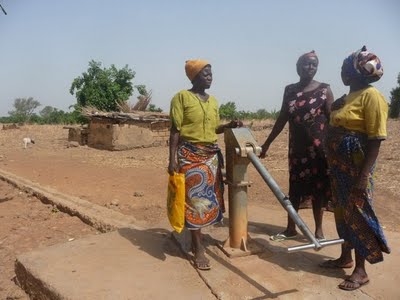Community Development: Strategies That Serve
Ask the community you serve what they want and need. Remember that your work should happen through, not to, the communities you serve.

You don’t want your nonprofit to make things worse for the community.
After working for decades in international development, we’ve learned a lot that applies to nonprofits of all kinds, especially those passionate about building resilient communities. Let’s begin by looking at how things can go sideways if you neglect the critical strategy of actually asking the community you serve what they want and need.
“This borehole was not built by me, nor for me. Now it’s just a reminder of what is broken.” These were the words shared by our colleague in Ghana, standing beside the only well in her village, which was installed by an international aid organization whose name no one in the village could recall and whose presence was long gone.

Replacement parts were nowhere to be found and villagers were not informed about maintenance or repair. And women (the primary water collectors in most of the developing world) were not included in planning where the well was placed or how it was constructed.
She explained that with a defunct well, the village was actually worse off—women and girls were forced to collect water at the nearby river contaminated with E. coli, or to walk to another village.
This scenario, or ones similar to it, have played out all across the world, anytime an organization attempts to impose a solution to a community without enlisting their input first, as passionately articulated in Ernesto Sirolli’s amazing TED Talk.
It’s a tragedy when nonprofits—with all the best intentions—end up actually making things worse for the communities they serve. In an attempt to not repeat these kinds of mistakes, Women’s Earth Alliance (WEA) was founded by a group of 30 women leaders from around the world who wanted to write a new story.
In our work we identified three strategies to powerful, lasting results in community development projects: positioning local leaders as the designers of their own future, ensuring their agency is front and center, and shaping solutions in teams versus silos.
Community Leaders as Designers and Owners of their Future
Old-model development can sometimes perpetuate the paradigm that there are those who “have” and those who “have not.” And those who “have not” need aid and need decisions made for them. But the problem is those in need rarely see themselves as victims.
In our work, we flipped this on its head and designed a strategy underpinned by the theory that, when availed access to vital resources, community leaders have the foresight, vision, and know-how to best design and implement solutions that last. What is most needed is to strategically support people to unleash and proliferate their firsthand knowledge and grassroots solutions. It’s less about “serving beneficiaries” and more about connecting leadership to bridge solutions and build networks of transformation.
We’ve seen this model work again and again. Whether your organization is working in an inner city or a community abroad, how do you include the community members themselves in the design of solutions and how to implement them?
Stakeholders’ Agency Front and Center
We realized early on that conventional development strategies often neglect to engage key stakeholders. This is true across all areas that nonprofits impact, not just in international development: key perspectives are often discounted in implementing solutions in youth services, healthcare, education, poverty, hunger, and so many other areas.
Yet, the people most vulnerable to any crisis are actually best positioned to address on-the-ground impacts and challenges. Sure, we typically think about “target beneficiaries,” but stakeholders’ contributions are consistently overlooked, underfunded, and under-prioritized. Don’t let this happen to you, no matter what your focus!
For WEA, this belief is our central driving premise—that when grassroots women’s leadership is centered, everyone thrives. In our case, we observed three consistent trends that you can easily imagine applying to your work, albeit likely with a different constituency at the core:
- Grassroots women leaders design community solutions with more precision, long-term vision, and holistic inclusivity than any outside aid worker.
- Grassroots women leaders often identify solutions that are otherwise invisible to aid professionals and to men, since they are often the ones bearing the brunt of the crises.
- The relationships and trust between grassroots women leaders and their communities increases the likelihood that these solutions will be welcomed and endure.
How are you encouraging stakeholder leadership in your community initiatives? What have you noticed about the success of solutions that are conceived and implemented by local leaders, as opposed to solutions imposed upon them?
Teams Rather than Silos
We regularly recall the words of a Swahili song: “If we were all here, all here together…We could do wonders.”
For all of us engaged in making change, our work exists inside of an intricate and whole system of many parts and thinking about it that way helps to ensure long-term success. Every program your nonprofit undertakes should be co-designed by a team of local organizations and advisors—each bringing a diverse set of skills, networks, and resources. The result is a stronger, more dynamic, and more resilient offering.
Leaders in our programs learn from each other as much as they learn from “experts.” They uplift, refine, and launch community-led solutions that work. We’ve supported this silo-tipping by inviting program participants to join in teams of two in order to support each other once they return to their communities; consider doing the same or identifying other ways to build bridges.
Rather than competing for funding, teams achieve exponentially greater impact by joining forces, thus enrolling a broader population, and integrating a diverse set of perspectives into each stage of their work.
How have you used teams and networks to connect people and create stronger program offerings? What best practices have you found in joining forces with others and integrating diverse points of view when designing solutions? Share below in the comments. We’d love to hear from you!
Always remember that your work should happen through, not to, the communities you serve. And when you employ the strategies of positioning local leaders as the designers of their own future, ensuring their agency is front and center, and shaping solutions in teams versus silos, your ability to do that increases exponentially, as do the results and impact of your work.
About the Author
Articles on Blue Avocado do not provide legal representation or legal advice and should not be used as a substitute for advice or legal counsel. Blue Avocado provides space for the nonprofit sector to express new ideas. Views represented in Blue Avocado do not necessarily express the opinion of the publication or its publisher.












[…] Blue Avocado is another great resource for nonprofits. A great article to start with is strengthening communities from the inside out. […]